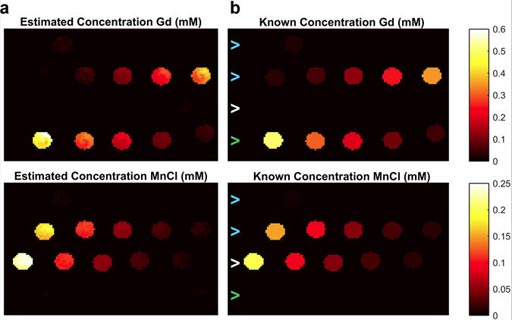New MRI Technique Offers New Capabilities and Earlier Detection
By MedImaging International staff writers
Posted on 29 Aug 2017
Researchers in the US have developed a new MRI technique that uses two contrast agents in parallel to map multiple characteristics in a single scan.Posted on 29 Aug 2017
The new technique, Dual Contrast - Magnetic Resonance Fingerprinting (DC-MRF) could be used for research, or to improve disease diagnosis by targeting molecules associated with disease, and other biomarkers. The researchers used gadolinium (Gd) and manganese (Mn) contrast agents that can be detected and quantified independently during a Magnetic Resonance Imaging (MRI) scan.

Image: Maps of the estimated gadolinium and manganese concentration from the DC-MRF technique (Photo courtesy of CWRU School of Medicine).
The researchers from Case Western Reserve University School of Medicine (CWRU; Cleveland, OH, USA) published their findings in the August 16, 2017, online issue of the journal Nature Scientific Reports. The authors included clinicians, engineers, nurses, basic science researchers, and members of the Case Comprehensive Cancer Center.
According to the authors, the new technique could be used for a wide range of imaging applications, and provides an adaptable, quantitative imaging framework for assessing the different contrast agents simultaneously. The technique will also provide clinicians with a new and unique imaging platform for studying molecular therapies.
Associate Professor of Radiology, Biomedical Engineering, and Pediatrics, Chris Flask, PhD, said, "The method we developed enables, for the first time, the simultaneous detection of two different MRI contrast agents. This multi-agent detection capability has the potential to transform molecular imaging, as it provides a critical translational pathway for studies in patients. Two contrast agents could include one specifically targeting diseased tissue, and one designed to show healthy tissue, for example. In this initial paper, we validated our new methodology, opening the possibility for numerous follow-on application studies in cancer, genetic diseases such as cystic fibrosis, and metabolic diseases such as diabetes."
Related Links:
Case Western Reserve University School of Medicine













